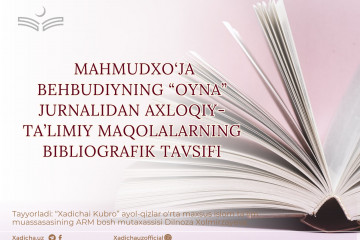
Intercultural Communication in Language Teaching: Building Bridges Through Education
Abstract
In the twenty-first century, language learning has become more than the acquisition of grammar, vocabulary, and pronunciation. It is also the study of how people think, interact, and live across cultures. This article explores the significance of intercultural communication in language teaching, with a focus on its relevance in moral and religious educational contexts such as Khadichai Kubro Women’s Madrasah in Tashkent. The discussion emphasizes that understanding another culture does not mean abandoning one’s own values; instead, it enables learners to engage in respectful and meaningful communication. The paper highlights the role of teachers, the integration of moral education, and the benefits of intercultural competence for young women in a globalized world.
Keywords: Language teaching, intercultural communication, cultural awareness, moral education, women’s education, Uzbekistan
Introduction
In today’s globalized society, communication has extended beyond national borders. People interact daily with others who speak different languages and come from diverse cultural backgrounds. In such a context, learning a foreign language—especially English—has become not only a linguistic task but also a cultural and moral journey. The study of language naturally involves the study of culture because language reflects the values, beliefs, and worldview of its speakers.
For students in institutions like Khadichai Kubro Women’s Madrasah, where education aims to develop both intellectual and spiritual growth, intercultural communication plays a unique and valuable role. It teaches students to respect diversity while maintaining their own cultural and religious identity. This balance prepares them to become effective communicators, educators, and ambassadors of Uzbek culture in the international community.
Intercultural Communication and Language Learning
Intercultural communication refers to the exchange of ideas and information between people from different cultural backgrounds. In language learning, it helps students understand not only what to say but how and why people express themselves in certain ways. For example, English speakers often value directness and clarity, while in Uzbek or Arabic cultures, communication may include more polite expressions, gestures of respect, or indirect forms of speech.
Teaching language without addressing cultural aspects can lead to misunderstanding and superficial learning. According to Byram (1997), effective language learning develops “intercultural communicative competence,” which includes knowledge of other cultures, curiosity, and the ability to reflect critically on one’s own culture. When students learn why certain words or customs are used, they begin to communicate more thoughtfully and effectively.
Furthermore, language learners who understand intercultural communication gain confidence when interacting with people from other countries. They can participate in global discussions, represent their nation with pride, and promote peace and understanding.
The Role of Teachers in Promoting Intercultural Awareness
Teachers are at the heart of intercultural education. Their guidance determines how students perceive and respect cultural diversity. A teacher who encourages open-mindedness and empathy can help students develop not only their language skills but also their moral character.
Practical classroom strategies include using authentic materials such as films, songs, stories, and news articles from different cultures. Teachers can also organize discussions where students compare cultural practices, analyze polite expressions, or explore international traditions while reflecting on Islamic and Uzbek values.
At Khadichai Kubro Women’s Madrasah, teachers can play a dual role: language educators and moral guides. They can demonstrate that intercultural understanding is not about copying others but about learning to coexist peacefully while staying true to one’s beliefs. As the Prophet Muhammad (peace be upon him) said, “The most beloved people to Allah are those who bring the most benefit to others.” This principle aligns perfectly with the idea of intercultural communication — serving humanity through understanding and respect.
Integrating Cultural and Moral Values in Language Classes
Language classrooms offer excellent opportunities to connect linguistic knowledge with ethical and spiritual values. For example, when discussing global issues such as kindness, honesty, or environmental care, teachers can introduce both English expressions and Islamic perspectives. This approach allows students to see that universal moral principles are shared across cultures, even if they are expressed differently.
Projects that encourage intercultural communication, such as virtual exchanges or pen-pal programs, can help students practice language skills while learning about others. However, it is equally important that students reflect on their own culture — writing essays, presentations, or dialogues that show pride in Uzbek traditions and Muslim identity.
This combination of outward learning (about others) and inward reflection (about self) creates balanced, mature, and culturally intelligent learners.
Benefits for Students in Religious Educational Contexts
In religious institutions like Khadichai Kubro Women’s Madrasah, intercultural communication strengthens not only academic competence but also spiritual and moral awareness. Students who understand multiple cultures become better equipped to share the positive values of Islam — peace, justice, and compassion — with the world.
Moreover, intercultural education empowers women. It gives them a voice in global discussions and confidence to participate in academic, professional, and community life. Learning to communicate with people from different backgrounds also helps them avoid prejudice and promotes harmony in both local and international relations.
Ultimately, intercultural communication supports the development of global citizens who respect others while staying rooted in their faith and heritage. Such women can become role models — showing that deep faith and open-mindedness can coexist beautifully.
Conclusion
Intercultural communication is not an optional part of language education; it is its essence. Through it, learners go beyond memorizing words and grammar — they learn to understand hearts and minds. For the students and teachers of Khadichai Kubro Women’s Madrasah, this approach offers a meaningful path that unites knowledge with faith, and language with humanity.
By integrating cultural understanding and moral values into language teaching, educators help build bridges of peace, respect, and wisdom. In doing so, they prepare a new generation of women who are linguistically skilled, culturally aware, and spiritually strong — ready to contribute positively to both Uzbekistan and the wider world.
References
Byram, M. (1997). Teaching and assessing intercultural communicative competence. Multilingual Matters.
Kramsch, C. (1998). Language and culture. Oxford University Press.
Woodrow, L. (2018). Introducing course design in English for specific purposes. Routledge.
Viana, V., Bocorny, A., & Sarmento, S. (2019). Teaching English for specific purposes. Cambridge Scholars Publishing.Serafini, E. J., Lake, J. B., & Long, M. H. (2015). Needs analysis for specialized learner populations: Essential methodological improvements. English for Specific Purposes, 40(1), 11–26.
By Munirakhon Khaydarova, Khadichai Kubro Madrasah, Tashkent
Другие новости



 УЗ
УЗ
 РУ
РУ
 EN
EN
 العربية
العربية
